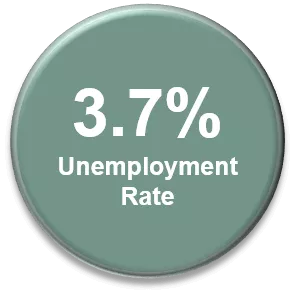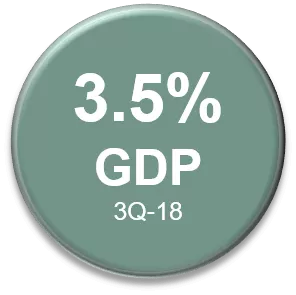Economic Commentary on October 2018 Employment Report
By John Beuerlein, chief economist, Pohlad Companies

Chief Economist
Pohlad Companies
Not surprisingly, the strong October Employment report released November 2 reversed the weak September report that was influenced by the impact of Hurricane Florence. Just as the September report overstated the weakness in the labor market, the October report probably overstates the strength, as rebuilding efforts are typically short-term stimulants to the steady state labor market. As for the details, October payrolls were reported to have grown by 250,000, or about 50,000 more than expected. Labor strength was broad-based across most industries. There were no signs of any trade-war impact in manufacturing employment or in other sectors.

The unemployment rate was unchanged at 3.7% with most new entrants into the labor force able to find jobs. Labor force participation (the number of people available for work as a percentage of the total population) is rising as employers are enhancing job offers not only with better pay, but also through better benefits and flexible work schedules. Part of the increased labor participation is also due to the seasonal increase with the upcoming holidays.
Earnings up year over year
The most eye-catching factoid from the October report was that average hourly earnings rose to 3.1% year over year. On a month-to-month basis, earnings were up 0.2% compared with 0.3% in September. The 3.1% year-over-year number (the highest year-over-year rate since May 2009) compares the October 2018 earnings number to the October 2017 earnings number, which was abnormally weak (-0.2% month-to-month) due to hurricanes last fall. Even though wages are improving, the 3.1% year-over-year number probably overstates wage growth strength. Despite the aberration in the year-over-year calculation of earnings noted above, the aggregate hours worked and aggregate income growth indicate that the labor market remains solid as we enter the fourth quarter.

GDP of 3.5% is down from 4.2% in 2Q
The report that has produced some discussion was released the previous Friday, October 26. This was the first reading of third-quarter 2018 GDP. The initial reading for 3Q-18 GDP is 3.5%, down from the 2Q-18 reading of 4.2%. Year-over-year growth improved to 3.0%. A breakdown of the report showed that the consumer, once again, led the economy in 3Q-18. Additional strength came from inventory growth and government spending. Weak growth in business investment and housing, however, temper the longer-term growth ramifications from the report. Importantly, the effects of the corporate tax reforms that were meant to incentivize business investment and enhance productivity growth appear to have stalled after providing a boost to capital spending in the first half of the year. Business investment in 3Q-18 was the weakest in nearly two years. Despite the best back-to-back quarters since 2014, it is not likely that this level of GDP growth is sustainable. Low unemployment levels mean that improved economic growth is dependent on improving productivity. Without continued business investment, productivity will likely stay muted. Additionally, the waning impact of the tax cuts, coupled with increasing interest rates, will likely slow consumer spending plans.
Inflation expectations
While we have seen some modest increase in inflationary pressures up to this point in 2018, the internal components of the inflation indices suggest that inflation will decelerate into the end of the year. Unit labor costs remain muted at 1.5% year-over-year. Until labor costs firm more appreciably, the transmission mechanism into overall consumer prices will remain constrained. The muted inflation outlook, coupled with increasing global financial stresses, will likely cause the Fed to continue to move slowly as they normalize interest rates.
Insights
Research to help you make knowledgeable investment decisions